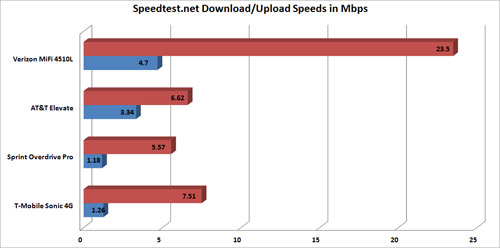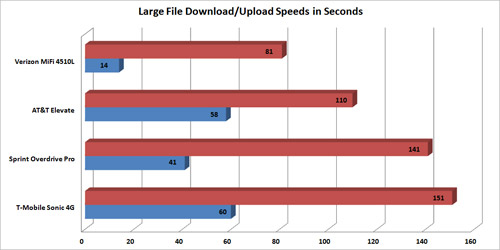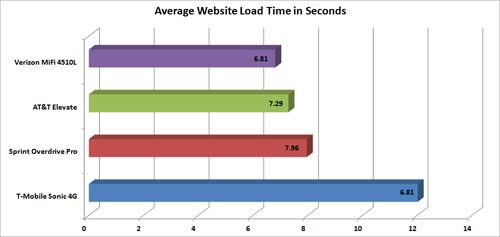Laptop Mag Verdict
The MiFi 4510L mobile hotspot offers blazing-fast speeds for up to five devices.
Pros
- +
Fastest speeds available
- +
Inexpensive
- +
Classy design
- +
Widespread 4G LTE coverage
Cons
- -
Limited data plan options
- -
Can't use while tethered to PC
Why you can trust Laptop Mag
When Verizon first introduced its ultra-fast LTE service in late 2010, it was a revelation. A carrier had finally delivered on the long-talked-about promise of at-home Internet speeds on the go. The Verizon Wireless 4G LTE MiFi 4510L mobile hotspot promises those blazing speeds for up to five devices at once. However, other carriers are now nipping at Verizon's heels with faster 4G networks of their own. Is this $49.99 gadget worth your two-year commitment, or should you look elsewhere?
Update: This reveiw replaces our older examination of the Verizon Wireless 4G LTE Mobile Hotspot MiFi 4510L.
Design
The 3.7 x 2.4 x 0.5-inch MiFi 4510L has a basic rectangle design that's about the size of a small stack of credit cards. It's roughly the same size as the AT&T Elevate 4G and the T-Mobile Sonic 4G, but it eschews the rounded design of the Sonic and the rubber edges of the Elevate. The bottom and sides are coated in soft-touch rubber, while the top is a sophisticated reflective black with smoky chrome trim and matching power button. The overall aesthetic reminds us of a modern skyscraper, though it's not as reflective and fingerprint-prone as the T-Mobile Sonic.
The top of the MiFi 4510L houses an E Ink display with indicators for signal, battery, and the number of devices connected. The display remains constantly visible, so a quick glance is all that's needed to instantly check signal and battery status. There's also a status light along the front edge of the device that flashes purple when searching for a 4G signal and changes to a steady green when one is found. The green light flashes when the hotspot is sending/receiving data. Unfortunately, the MiFi doesn't display how much data you've consumed like the Elevate 4G.
The back edge of the 4510L houses a microUSB port and a port for attaching an antenna. Unlike other mobile hotspots, this one doesn't include a microSD card slot. This hotspot can connect to up to five devices at once.
Coverage
Verizon's 4G LTE network is available in 178 markets. Verizon promises download rates between 5 to 12 Mbps and uploads between 2 to 5 Mbps, but our test results were much faster than that.
Features
Unfortunately, you can't charge the 4510L over a USB connection to a notebook and broadcast a Wi-Fi signal at the same time like you can with the Samsung SCH-LC11 and the Sprint MiFi 4082 (which even supports sharing an Internet connection directly over USB). When connected to a PC, the device shuts down the wireless radios and charges the 4510L's battery. In order to use the 4510L while charging, you'll need to plug in the AC adapter.
Like with most routers, you can access the 4510L's settings via its URL. There you can change the password, see other connected devices, set the hotspot to power down if it idles, and adjust the security settings. The control panel also shows you the device's battery life, connection strength, and the type of data network access available (3G or 4G).
Typically, mobile hotspots built by Novatel (such as the Sprint MiFi 4082) include the manufacturer's proprietary MiFi OS, a mini operating system which users can access in the router's control panel to take advantage of location-based services such as local business search and weather updates. However, the MiFi 4510L doesn't include this software because the GPS chip inside the device comes deactivated.
Performance
Verizon's LTE network was fun to test in Chicago--just to see how crazy fast it can get. However, we were also very impressed by the consistency of the network's speed and coverage. At all three of our testing locations, in Lincoln Park, Mayfair, and the near-west suburb Oak Park, the MiFi 4510L maintained four full bars of service.
We ran the download and upload tests on Speedtest.net 10 times in three locations for all four of the hotspots. The MiFi 4510L consistently flew past the other hotspots with an average download speed of 23.5 Mbps. That's 16 Mbps faster than its closest competitor, the T-Mobile Sonic 4G. By comparison, the AT&T Elevate 4G averaged 6.62 Mbps and the Sprint Overdrive Pro averaged 5.57 Mbps, although the AT&T hotspot delivered a much faster 24 Mbps down in Houston. The MiFi 4510L was even 5 Mbps faster than our home Internet connection.
Speedtest.net upload speeds were just as strong, with the MiFi posting an average speed of 4.7 Mbps, though AT&T's LTE is catching up; the Elevate's average upload was 3.34 Mbps. In Houston, the AT&T hotspot averaged a much higher 11.5 Mbps.

Click to enlarge
Large File Downloads and Uploads
Large file download and upload speeds were equally strong. The MiFi 4510L downloaded a 151MB file in an average of 81 seconds, while AT&T came in at 110 seconds. Sprint and T-Mobile brought up the rear with times of 141 and 151 seconds, respectively. The story was the same when uploading a 6.5MB file: Verizon's hotspot completed the job in an average of 14 seconds, while Sprint took 41 seconds, and AT&T and T-Mobile came in near the minute mark with times of 58 and 60 seconds.

Click to enlarge
Web Surfing
Downloading and uploading is all fine and good, but how long will it take you to load a website? Using a Dell Inspiron 15 and Google's Chrome browser, we timed how long it took for Laptopmag.com, CNN.com, ESPN.com, and NYTimes.com to load. The MiFi 4510L took an average of 6.8 seconds. This is speedy, but not as fast when you consider that the Elevate took an average of 7.2 seconds to load the same pages and the Sprint Overdrive Pro took an average of 7.9 seconds. The T-Mobile Sonic 4G did its best impression of 3G with an average of 12.01 seconds.

Click to enlarge
Battery Life
Verizon rates the MiFi 4510L's battery for up to five hours of use. We didn't have to reach for the charger even after several days of intermittent use. After fully charging the hotspot in the morning, we used the MiFi for about four hours and the battery was still half full.
Data Plans and Value
Verizon Wireless currently sells the MiFi 4510L for $49.99 new or for $19.99 refurbished with a two-year contract. It's coupled with either a 5GB plan for $50 a month or a 10GB plan for $80 a month. Going over those limits will set you back an extra $10 per GB. T-Mobile offers the same pricing plans, but instead of charging extra if you go over your monthly limit, the carrier will throttle your speed. T-Mobile also offers a 2GB plan for $40 a month. AT&T pairs its $69.99 Elevate hotspot with a 5GB/$50 monthly plan and also charges a $10 per gigabyte overage. Sprint charges $60 a month for 5GB of 3G and 4G data but starts at a lower $44.99 for 3GB of 3G and 4G.
Verdict
Comparing the MiFi 4510L on Verizon's LTE network to other hotspots is like bringing a Harley to a bicycle race. It offers screaming-fast performance, and although AT&T offers 4G LTE speeds too, it's only in a handful of locations right now. Verizon offers much more comprehensive coverage along with consistently fast performance. Our biggest issue with the 4510L? The data rates are so good that you could easily blow through the 5GB cap in Verizon's lower-cost plan. Power users should step up to the $80 10GB plan.
Verizon 4G LTE MiFi 4510L Specs
| Company Website | http://www.verizonwireless.com |
| Data Connection | 4G, LTE, EV-DO Rev. A, CDMA |
| Ports | microUSB, External antenna |
| Size | 3.7 x 2.4 x 0.5 inches |
| Supported Protocols | 802.11b/g/n, 4G, 3G |
| VPN Support | Yes |
| Weight | 3.2 ounces |
